Here are a few of the more common topics that people have emailed us about:
(Can't find what you're looking for? You can always email us!)

What is “My Little Pony”?
My Little Pony is the name of a line of pony toys created by Hasbro. There are four different “generations” of My Little Pony: the original toys were introduced in 1982 and printed until 1992 in the US (production continued longer in some countries). A second line of pony toys was released in 1997, and a third line was released in 2003; the fourth line is available in stores now. This website, Ponyland Press, is devoted exclusively to the original ponies from the 80’s and early 90’s, often called “G1” (generation one) ponies.
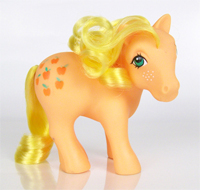
The majority of G1 My Little Pony toys are made of pliable, colorful plastic and stand about 5 inches tall. They have colorful, brushable hair and colored symbols printed on their flanks. Most of them are simply earth ponies, but about a third are either unicorns or pegasus ponies. Others are Sea Ponies (similar to seahorses) or Flutter Ponies (with iridescent, insect-like wings), or other variations, and a few are not ponies at all (there is a camel, a zebra, and so on). There are also Baby Ponies, Newborn Ponies, and Teeny Tiny Ponies.

Almost all ponies were released in “sets” whose members all have some special feature in common, such as glittery paint, fruit-themed symbols, flocked bodies, scented plastic, etc. Each pony who was available in stores came with accessories, ranging from a single comb to an entire playset. Each pony also came with “Horseshoe Points” printed on her box or card; by collecting and mailing in points, you could get discounts on special-offer ponies from brochures.
Naturally, there were also My Little Pony books, games, puzzles, clothes, and endless other merchandise, plus several movies and two TV series, “My Little Pony and Friends” and “My Little Pony Tales.”
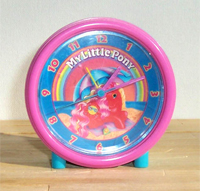
In addition to My Little Ponies themselves, Hasbro produced several other kinds of toys under the name My Little Pony, including Dream Beauties, Petite Ponies, Plush Ponies, and Lil’ Litters. Dream Beauties are about twice the size of regular ponies, appear more slender and horse-like, and are made of much harder plastic. Petites are tiny hard plastic ponies, less than an inch tall, with molded plastic hair. Plush ponies are large, stuffed, cloth pony toys. Lil’ Litters are flocked puppy, kitty, and bunny toys who come with litters of two babies each; these toys are smaller than their pony counterparts and don’t have symbols printed anywhere on their bodies. The My Pretty Pony, a large, hard plastic pony resembling Peachy, was the precursor to My Little Ponies.
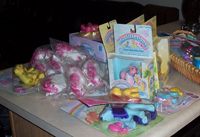
My Little Ponies were sold all over the world, and many particular ponies or sets of ponies were sold exclusively in the UK, Germany, France, Spain, Italy, Greece, Mexico, Brazil, Argentina, Peru, Macau, and even India and Africa. Not all of them were manufactured by Hasbro -- Argentinean ponies, for instance, were produced by Top Toys, Inc. Some are very rare and expensive.
Of course, there are a lot of colorful pony toys in the world that are not My Little Ponies. Within the My Little Pony community, such toys are known as “fakies.” (See below for more information on fakies and how to tell them apart from real My Little Ponies.)
What are vintage My Little Ponies worth?
The market for ponies is constantly changing, and what a particular pony is worth will depend on several factors, including how rare or desirable the pony is, what kind of condition the pony is in, and what the current market for ponies is like. Most ponies, if they are in very good condition, are worth around $8-$15; damaged ponies are usually worth less. Ponies who are highly desirable, or hard to find in good condition, may be worth $20-$50, and a few rare ponies—mostly foreign or special offer ponies—are worth even more, especially if they are in excellent condition or come with their original accessories. Only a handful of ponies regularly sell for more than $100; 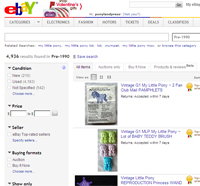 Rapunzel and Sweet Scoops often sell for several hundred; and the extremely rare Greek Easter Pony usually sells for over $1000.
Rapunzel and Sweet Scoops often sell for several hundred; and the extremely rare Greek Easter Pony usually sells for over $1000.
If you’re looking to buy or sell a pony and aren’t sure what she’s worth, the best place to ask is either the My Little Pony Arena or the My Little Pony Trading Post; these are both message boards with large, active communities of pony collectors who can give you up-to-date information about prices.
If you’re planning on selling My Little Ponies, keep in mind that a pony in mint condition is worth considerably more than a pony in played-with condition. Cropped hair, mold spots, stains, rubs, and marks will drastically reduce the worth of many ponies. Also, the way a seller presents or describes her ponies will often affect the price they sell for; poor photography, unclear descriptions, and bad shipping policies will drive buyers away.
Why don’t the dates on my ponies’ hooves match the release dates listed on your site?
The dates printed on the bottom of a pony's hoof is not the date when the pony was printed. It is the copyright date for the pose. What this means is that the date on the hooves corresponds to the date the pose was first introduced. Every pony printed in the Bow-Tie pose, for instance, will have the date 1984 on her hoof, including ponies like Sand Digger and Napper, who were printed much later. Sweet Blossom, a Year 10 pony printed in 1991, is marked as a 1984 pony, because her pose was introduced in Year 3 (1984-5) with the ponies Posey and Lickety Split.
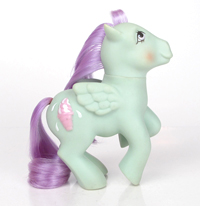
How can I identify which pony I have?
One way is to use a pony identification form. These are available on various pony websites; we intend to put one up here eventually.
Another way is to post a photo or description of your pony to a message board or community, such as the MLPTP or the MLP Arena. There are lots of collectors there who will be able to answer most, if not all, of your pony questions.
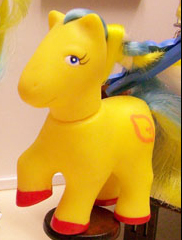
What is a “fakie”?
A “fakie” is a toy that is similar to a My Little Pony, but not a real My Little Pony. Most fakies are easily recognized by their cheaply-printed symbols, thin hair, squinty or overlarge eyes, painted hooves, disproportionateness, or plain ugliness. For photos and descriptions of some different kinds of fakies, have a look at The Fakie Hideout.
Note: Most fakies are worth next to nothing, and if you try to sell them together with real My Little Ponies on eBay, you may end up losing money—the increased shipping cost due to the fakies will put off many buyers. If you want to get rid of your fakies, you’re probably better off taking them to a thrift store.
How can I tell a fakie from a real My Little Pony?
The first thing to check is the bottoms of the pony’s hooves. If they don’t say “Hasbro” anywhere, it’s probably a fakie, unless it happens to be a rare foreign pony; some ponies in South America and parts of Europe were manufactured by companies other than Hasbro. (Also note that Dream Beauties, Petite Ponies, plushies, 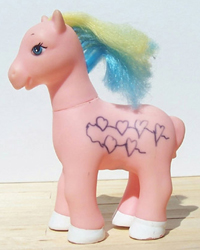 and some other types of My Little Pony products do not have “Hasbro” printed on their hooves.)
and some other types of My Little Pony products do not have “Hasbro” printed on their hooves.)
If the pony’s hooves do say “Hasbro,” it’s likely that what you have is a real My Little Pony—though not necessarily a vintage pony. (See below for notes on how to tell different generations of My Little Ponies apart from each other.) However, note that Hasbro did make a few colored pony toys which were not My Little Ponies. The most common are the Cabbage Patch Ponies, which are larger and bulkier than My Little Ponies, with bulbous noses, small eyes, and hooves distinct from their legs. You can see photos of these and other fakies at The Fakie Hideout.)
Another way to find out if your pony is real is to use a pony identification form, which should tell you which My Little Pony you have, if you have a real pony. If you’re still in doubt, try posting a photo or description of your pony to the MLPTP or the MLP Arena; the members of these message boards will be able to tell you more about your pony.
How can I tell a vintage (1980s-90s) My Little Pony from the later generations?
There are a few ways to easily tell an average vintage My Little Pony from a 2nd, 3rd, or 4th generation pony. The only real difficulty comes in comparing newer ponies to more unusual types of vintage ponies.

G1 ponies are usually about 5 inches tall; babies are 2½ - 3 inches tall. Almost all G1 ponies have symbols printed on both sides of their bodies. Most G1 ponies have large eyes with two eyelashes at the top and two at the bottom, and largish ears with a straight, simple shape. They have thick but finely shaped bodies and are a little more angular at the knees and the points of their hooves than any later ponies. G1 pegasus ponies have plastic wings molded to their bodies, never extended outward or raised up. Their wings are always the same color as their bodies, except in the case of Rainbow Curl pony Ringlets.
G2 ponies are smaller than G1 adult ponies, and have slender bodies with long necks and knobby knees. They have molded fur on their hooves, and their faces are distinctive, with small, round noses and small ears that point forward. They have small plastic gemstones in their eyes, and they have two sets of eyelashes on top (two small lashes in front and three larger ones in the back), but no bottom eyelashes.
G3 ponies are just a little shorter than the average G1 pony, but they have several distinguishing features. Unlike G1 ponies, they have a symbol printed on only one side of their bodies. They also have a small heart printed on one of their front hooves; the underside of this hoof contains a magnet. They have a small heart printed in each eye, and their eyes are larger and rounder than G1 pony eyes. Their bodies are rounder but smaller than G1 bodies, and their legs are slimmer and shorter, usually with rounded contours. Their ears are more shapely than G1 pony ears, curving upward to a point. Their tails are thinner than G1 tails, but their manes are thicker and usually include several different colors, often in many small stripes.
G4 ponies are about the height of G1 baby ponies, roughly 3 inches tall, but they do not look like G1 ponies. They have long legs, slender at the top but with large hooves in a bellbottom shape. Their bodies are extremely small, and their heads are very large—larger than their bodies. They have large foreheads, large ears, and enormous eyes, and their noses are extremely tiny. Like G3 ponies, they have symbols printed on only one side. Their eyes come in various shapes, some round, others almond-shaped, but they always have two white dots in them, one large, one small. They often have many eyelashes.
These are the basic differences between later generations of ponies and the original series; however, it is worth remarking that a lot of G1 ponies were unusual, and do not fit the description given above.
Where can I buy vintage My Little Ponies?
Occasionally, you may be able to find vintage G1 ponies at thrift stores or swap meets, but as time passes, this becomes increasingly unlikely. Antique stores will sometimes carry a few G1 ponies, but they are often overpriced, even when they are in very poor condition. Your best bet for finding the ponies you’re looking for is to buy them on the internet.
One of the easiest ways to buy ponies is to bid for them on eBay. The advantages are that eBay is a very large site and there are always hundreds of My Little Ponies and other pony items for sale there, and you can easily check a seller’s feedback to see whether it seems safe to make the purchase. Another advantage is that occasionally, you can get an excellent deal on a rare pony, if nobody else notices it and outbids you. The main disadvantage of eBay is that ponies are often overpriced as Buy It Now auctions, or go for unusually high prices because of eager shoppers trying to outbid each other at the last moment. If you’re bidding on a rare pony, expect the price to go up dramatically in the last few seconds before the auction ends. Some sellers will also charge high shipping fees.
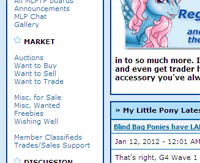
Another way to buy ponies online is to find collectors who have ponies to sell. The My Little Pony Arena and the My Little Pony Trading post are good places to look; these are the two major message boards where members of the MLP community post the items they have for sale or trade, or where sellers link to the sales pages on their private websites. You can often get better deals on ponies from these sellers, who are not paying eBay fees and who have a better understanding of what their ponies are really worth. Their shipping prices are usually more reasonable as well. The disadvantages are that feedback is sometimes harder to confirm for sellers on message boards, and the process of hunting for a particular pony that you want may take longer.
Whether you’re buying ponies on eBay or from other online sellers, you will probably need a PayPal account; almost all sellers use PayPal. If you can’t use PayPal, make sure the seller is willing to accept another form of payment.
(You can also check out the ponies for sale from Ponyland Press on our sale/trade page.)
How can I sell vintage My Little Ponies?
The best place to sell ponies is online, since that’s where most of the pony community goes looking for ponies to buy. Your two best options are to sell your ponies on eBay or another auction site, or to advertise them as “for sale” on a major MLP message board like the MLP Arena or the MLP Trading Post. You can also combine these methods by selling your ponies on eBay and advertising the eBay auction at one of the message boards.
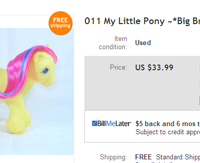
The advantage of selling on eBay is that your ponies are available to a very large market, so your ponies are likely to sell unless they are very common or overpriced. You also have eBay’s protection if a buyer backs out on a purchase. The disadvantage is that you have to pay a fee to eBay for listing the item and another fee if it sells, which is why ponies on eBay often cost more, or have higher shipping fees, than those sold on other sites. You also have a limited time to sell your item; if it doesn’t sell before the auction ends, you have to relist it. Selling on eBay is risky; sometimes a pony will sell for an unusually high price, but many ponies also sell for low prices if nobody is especially eager to buy them at the time of the auction.
The advantage of selling ponies through a message board like the MLP Arena or the MLPTP is that you can fix your prices, and there’s no charge for selling ponies there. Your sales page will be available until you decide to close the sale. You can also offer your ponies for trade, if there are other ponies you’d like to have in exchange. The disadvantage is that you have no guarantee until the payment is made; buyers will sometimes commit to buy a pony, promise payment for several days or weeks, and then back out. Your ponies may also not sell as quickly on message boards as they would on eBay.

Generally speaking, eBay is a good option if you want to get rid of your ponies quickly, especially if you offer them in a large lot or several smaller lots and are willing to risk losing a little money. Message boards are a friendlier, more community-based option, and work very well if you’re not in a hurry and would rather make sure your ponies sell for the right price, or are interested in trading.
Note that wherever you sell your ponies, you will probably need a PayPal account; most buyers prefer not to send checks or money orders, since the process takes longer and is often less secure.
How can I clean or repair a damaged pony?
We'll have more information about cleaning and repairing ponies as soon as we put up the Restoration section of the website. For now, ask around at the MLP Arena or the MLPTP; you can find excellent tutorials for cleaning and restoring ponies at both message boards.
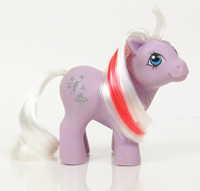
What is a "custom"?
A custom pony is a pony that has been altered by a collector or artist. Customization can mean removing and changing a pony's symbol, using dye or paint to change a pony's body color, rehairing a pony to give her a new hair color, molding wings or a horn onto a pony with clay, etc. Customizing ponies can be an excellent way to rescue ponies who are in very bad condition ("custom bait"), but be careful not to customize rare or mint condition ponies! Eventually, Ponyland Press will have more information on techniques for restoring or customizing damaged ponies.
What do all these acronyms (SS, TAF, MIP, etc.) mean?
There are a number of special acronyms that are commonly used within the My Little Pony community, such as CF (Concave Footed), NM (Near Mint condition), or WTT (Wanted to Trade). Click here for a list of some of the most common acronyms and terms associated with My Little Pony collecting.
I’m looking for a certain pony. Will you sell her to me?
Unless the pony is listed on our sale/trade page, the answer is no. We never sell any ponies from our own collection. We’ve had most of them since we were kids.
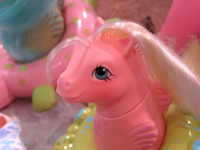
My company would like to advertise on your website. Can we arrange that?
We've been rather surprised to receive several offers for paid ads. The answer is no; Ponyland Press is a not-for-profit website, and will always be ad-free.
If you'd like, of course, you're more than welcome to donate!
Include your address, and we'll send you a pony thank-you card. :)

